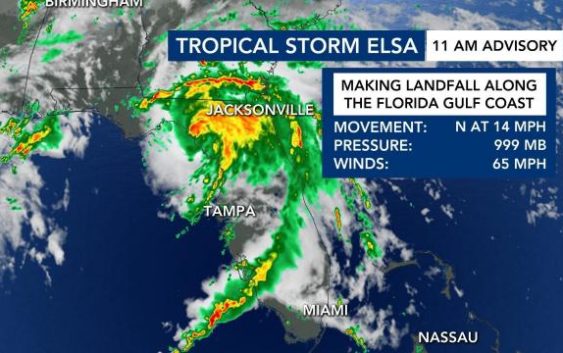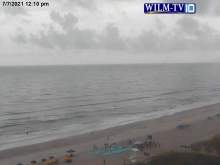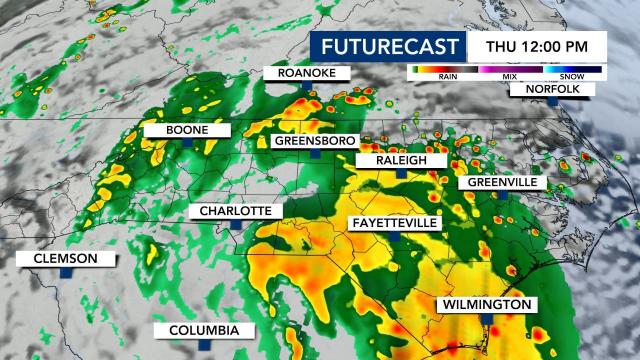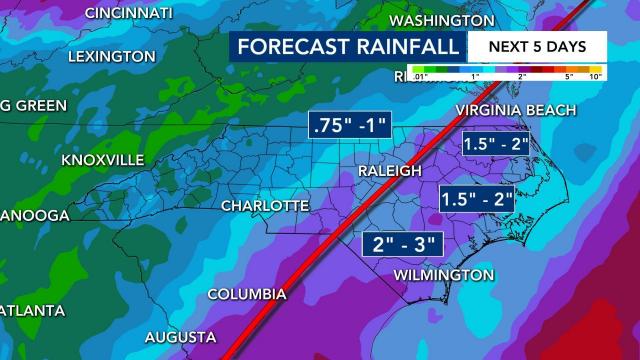- Hurricane survival kit: How to keep your family safe when a hurricane hits
- Houston-area storm damage: Update on status of schools, power outages and resources for storm victims
- EF-1 tornadoes ripped through Cypress, Waller County areas with winds at more than 100 mph, NWS reports
- Houston-area storm damage updates: Clean up continues after NWS says two EF-1 tornadoes and powerful derecho ripped through SE Texas
- Low risk of damaging winds, hail from Saturday storms
Tropical Storm Elsa makes landfall in Florida, scheduled to hit NC as tropical depression

ST. PETERSBURG, Fla. — 11 a.m.: Tropical Storm Elsa made landfall along the North Florida Gulf Coast on Wednesday morning, arriving in Taylor County.
The National Hurricane Center’s 11 a.m. update says Elsa is moving north at 14 mph with maximum sustained winds at 65 mph. Elsa is now forecast to impact North Carolina Thursday as a strong Tropical Depression.
A weakened Elsa dumped rain across Florida’s northern Gulf Coast early Wednesday but appears to have spared the state significant damage and widespread power outages.
The NHC issued a Tropical Storm Watch for North Carolina’s coastal areas initially before the watch was extended west to some inland counties on Wednesday morning. Swells of five to eight feet are possible, along with tropical storm force winds.
By Thursday morning, rain from Elsa arrives in the southern counties of central North Carolina, including Scotland and Richmond. The storm track brings it across North Carolina just southeast of Raleigh as a tropical storm before an eastward turn takes it back out over the Atlantic Ocean.
The forecast cone shows the storm could cross North Carolina anywhere from the Triad to the coast.
Heavy rain will be widespread across central and eastern North Carolina between 6 a.m. and 4 p.m., with the chance for lighter showers continuing until about 8 p.m. A look from Futurecast at noon on Thursday shows widespread rain across the region.
The rip current threat will also be high to moderate along the North Carolina coast on Wednesday.
“We could have some wind gusts up to 40 miles per hour and perhaps some isolated tornadoes as well,” said WRAL meteorologist Aimee Wilmoth.
The storm also presents a significant flooding risk, largely east of the Triangle. Most of eastern North Carolina is under a medium risk for flooding.
The biggest concern will be flooding with 1 to 3 inches of rain likely, and localized 4 to 5 inches possible. The good news is that river flooding is not expected, according to WRAL meteorologist Kat Campbell.
Elsa makes landfall in Florida
Elsa wobbled through the Gulf of Mexico, briefly reaching hurricane strength, but moved ashore as a tropical storm, the U.S. National Hurricane Center said Wednesday in its 11 a.m. advisory. The storm made landfall in lightly populated Taylor County with a maximum sustained winds clocking 65 mph (105 kph).
Tornado warnings were issued in several northern Florida counties, including the Gainesville area, on Wednesday morning. Heavy rain and gusty winds are expected across northern Florida once the storm makes an expected turn to the northeast. Some flooding is also expected in the region, where the ground is already saturated from heavy rain late last week.
Gov. Ron DeSantis said at a morning news conference that no major structural damage or deaths from the storm had been reported.
“Clearly, this could have been worse,” the Republican governor said, adding that many storm-related deaths come after the system passes. “Be very careful when you’re working to clear debris,” he said.
Tropical storm warnings were canceled for Cape Coral and Fort Myers. Further north, the Tampa Bay metropolitan area — while wet and windy — appears to have emerged mostly unscathed. Tampa was no longer under a hurricane warning, but weather forecasters warned of tropical storm conditions, including strong winds and flash flooding.
DeSantis said there were up to 26,000 customers without power in the region, most of them in Hillsborough, Pinellas and Polk counties that surround Tampa Bay. Crews were working to restore electricity and DeSantis said no hospitals reported an outage, which has been a major problem in past storms.
“We’re fortunate to see minimal damage & flooding this morning, but it’s important to keep safety top of mind. Be aware of your surroundings & don’t drive through flood waters,” Tampa Mayor Jane Castor said via Twitter.
The storm was moving northward, almost parallel to the west coast of the state, according to forecasters.
Schools and government offices in the Tampa area were closed and most public events postponed as Elsa approached Tuesday. Castor, however, predicted hockey’s Stanley Cup finals game between the Tampa Bay Lightning and Montreal Canadiens would be played as scheduled Wednesday night.
Tampa International Airport suspended operations at 5 p.m. Tuesday and planned to resume flights at 10 a.m. Wednesday following a check for any storm damage, according to its website.
Earlier Tuesday, Elsa swept past the Florida Keys but spared the low-lying island chain a direct hit.
The U.S. Coast Guard said 13 people were rescued from a boat that had left Cuba with 22 people aboard late Monday. Nine people remained missing.
The storm also complicated the search for potential survivors and victims in the collapse of a Miami-area condominium on June 24. Despite that challenge, crews continued the search in the rubble of Champlain Towers South in Surfside, Florida, on the state’s southeast coast.
Forecasters said Elsa would slice across inland north Florida as a tropical storm with strong rains and wind, then move on to Georgia, the Carolinas and Virginia before heading out in the Atlantic Ocean by Friday. A tropical storm watch was in effect early Wednesday for the coasts of North Carolina and Virginia from Duck, North Carolina to Chincoteague, Virginia, and for the Chesapeake Bay south of New Point Comfort.
In Georgia, a tropical storm warning was posted along the portion of the coast of Brunswick, with the National Hurricane Center saying tropical storm conditions with sustained winds of up to 50 mph (80 kph) are expected in parts of southeast Georgia.
“Right now, we’re basically looking at a cloudy, rainy and windy day,” Glynn County Emergency Management Agency Director Alec Eaton told the Brunswick News on Tuesday. “I feel confident we can sit down and let it pass over us without any major impacts. Hopefully.”
To the north in South Carolina, emergency officials were watching Elsa, but no evacuations were ordered during the peak summer beach tourism season. The storm was expected to track inland, but coastal forecasters noted the worst weather was on the east side of the storm and could dump up to 5 inches (13 centimeters) of rain and bring wind gusts up to 55 mph (88 kph) in places like Hilton Head Island, Charleston and Myrtle Beach.
Earlier, Cuban officials evacuated 180,000 people against the possibility of heavy flooding from a storm that already battered several Caribbean islands, killing at least three people.
Elsa is the earliest fifth-named storm on record, said Brian McNoldy, a hurricane researcher at the University of Miami.
___
Associated Press writers Jeff Amy in Atlanta, Freida Frisaro in Fort Lauderdale and Jeffrey Collins in Columbia, South Carolina contributed to this story.


